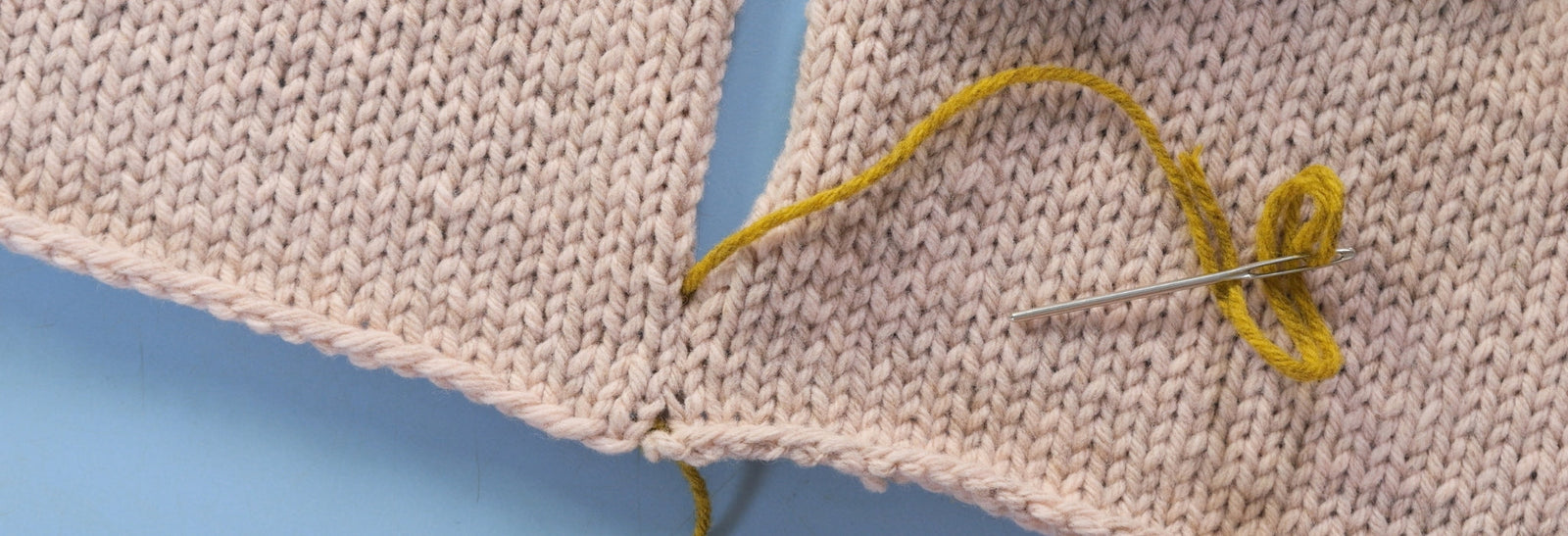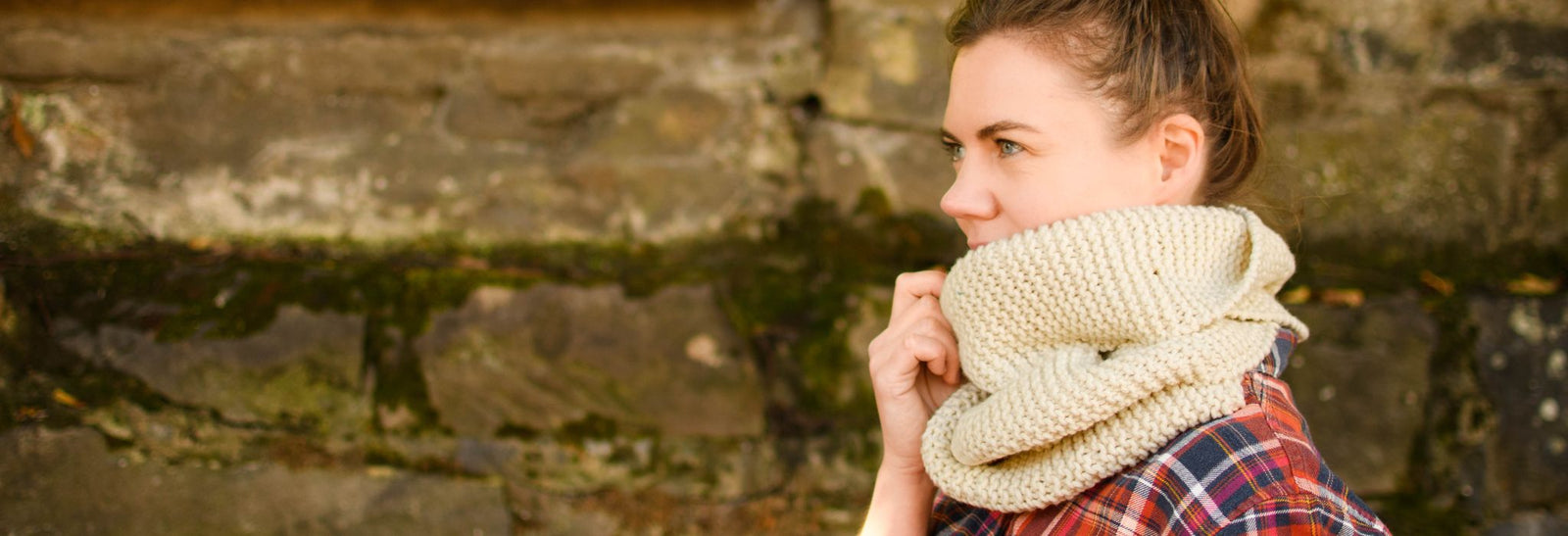Your Cart is Empty

Learn to knit: How to knit in the round
November 25, 2021
Learning to knit on circular needles opens a world of possibilities in knitting! Circular knitting eliminates the need to sew seams to create a continuous fabric.
Rather than turning your work after each row as you would with knitting flat, you keep knitting around and around in the same direction, creating a seamless tube of knitting. When knitting in the round, the outside of the tube always faces you as you - this makes it easy to maintain stitch patterns or work colour patterns.
Once you learn how to knit in the round, you can create all sorts of seamless projects, like cowls, hats, mitts, and seamless sweaters. Plus, you can never drop and lose one needle! This tutorial covers the basics of knitting in the round with one circular needle, appropriate for hats, cowls, and sweaters.
For simple knitting in the round, the circumference of your project needs to be large enough for the stitches to fit around the needle. For smaller cicumferences, like socks and sleeves, you'll need to use a different technique. Check out our tutorials on Knitting with Double Pointed Needlesand Magic Loop for more on knitting small projects in the round.

What are circular needles?
Circular needles are a pair of knitting needle tips that are connected with a flexible cable. Circular needles come in all the same sizes as straight needles, and in different lengths. The needle tips can be made of wood, bamboo, plastic, or metal. The cables used in circular needles vary greatly depending on the brand of needle, so try a few until you find one you like!
The length you’ll need depends on the circumference of your project, as you need a circular needle that is a bit shorter than the finished circumference of the stitches. Here are some common lengths and the types of projects you can use them for:

- 16" / 40cm and 20" / 40cm: Cowls, hats, baby sweaters
- 24" / 60cm: Cowls, baby and child sweaters, adult sleeves, adult sweaters (depending on size)
- 32" / 80cm and 40" / 100cm: Adult sweaters, shawls, blankets. Longer lengths are also available in some needle brands for particularly large projects. These lengths can also be used with the Magic Looptechnique for projects with smaller circumferences such as mitts, socks, and sleeves.
Circular needles can hold many stitches on the cable, since they can bunch together. Generally, a circular needle can hold at least twice as many stitches as its length - so a 24” needle could hold 48” worth of stitches. Some knitters prefer to have more stitches bunched up on a shorter needle, while others like to have more room between the stitches on a longer circular. It can be frustrating to use a circular needle that is much shorter or longer than needed, so check your pattern requirements.

How to knit in the round on one circular needle

Cast on all the stitches
You can use any type of cast on that you prefer. If you use a two-needle cast on like the cable cast on, you will use one needle in each hand as for straight needles - except that the needles are connected to each other. Once you’ve cast on all your stitches, they should fill the length of the circular needle.

Be careful not to twist
As you cast on, the stitches have a tendency to spiral around the needle. This is completely normal, but you’ll need to make sure you don’t have any twists before you start knitting in the round. To do this, work your way across the circular needle making sure that the bottom of the cast-on edge is facing the same way all the way across.

Join to work in the round

Distribute your stitches so they reach all the way to both needle tips. The working yarn should be attached to the right needle so that you’re ready to knit.

Place a stitch marker on the right needle to indicate the beginning of the round. Then insert your right needle tip into the first cast on stitch on the left needle and knit or purl it in pattern. Your work is now joined!

Knit in the round
Continue knitting across your stitches.

As you work from right to left, your completed stitches will gather on the right needle and move down onto the cable.

Slide the unworked stitches up to the left needle tip to work them. As you knit, you’ll develop your own way of knitting and sliding the stitches around the circular needle.

When you reach the beginning of round marker, you’ve completed one round.

Slip the marker from the left needle to the right needle and continue knitting.

Tips and Tricks
- The cast-on edge can appear tight when you first cast on, but it will relax once you’ve knit a few rounds.
- You can join a new strand or ball of yarn anywhere in the round, or just at the beginning of the round if you prefer.
- When putting your work down for a break, ensure that you’ve worked at least one stitch past the beginning of round marker - otherwise it might fall off!
- Knitting on a circular needle is a spiral - the first stitch of the round is slightly lower than the last stitch of the round. Keep this in mind while working stripes or other patterns, as they will not line up perfectly across the beginning of the round.
- Your gauge might be different when knitting in the round vs flat. Check out our tutorial on swatching in the round for tips on how to swatch for projects knit in the round.

Whether you knit in the round on one circular, double pointed needles, or Magic Loop, circular knitting is an easy and fun way to create seamless knits! Practice what you've learned with our free beginner hat pattern.
Also in Journal

Learn to Knit: Mattress Stitch
March 29, 2023
By following our step-by-step mattress stitch knitting tutorial, you'll learn how to make your seams look beautiful and how best to prepare your knitting so that when you seam it with mattress stitch, it goes smoothly on the first try.
Read More
How to Knit a Scarf: A Beginners Guide to Scarf Knitting
March 23, 2023
Want a quick and easy beginners tutorial on how to knit a scarf? This garter stitch scarf is easy to knit and requires just 3 skills; casting on, the knit stitch and casting off.
Read More
Learn to knit: the long tail cast-on
February 03, 2022
The long tail cast on is a great multi-purpose knitting cast on and the perfect place for beginner knitters to start. Learn how to work the long tail cast on and how to estimate the length of yarn needed with our clear step by step tutorial and video.
Read More Recent Articles
- Learn to Knit: Mattress Stitch March 29, 2023
- How to Knit a Scarf: A Beginners Guide to Scarf Knitting March 23, 2023
- Learn to knit: the long tail cast-on February 03, 2022
- How to Kitchener Stitch December 09, 2021
- Crochet Provisional Cast-on December 02, 2021
- Learn to knit: How to knit in the round with double pointed needles November 25, 2021
- Learn to knit: How to knit in the round using the magic loop technique November 25, 2021
- Learn to knit: How to knit in the round November 25, 2021
- Knitted Gift Ideas for you and your loved ones November 18, 2021
- Celebrating our Porty Hat Preview Knitters October 28, 2021
Free resources
-
KALS, step-by-step pattern guides and free patterns
Learn brioche with the free Daniel's Hat pattern
Tombreck - a free chevron beanie pattern
Working the brioche neck detail on the Polwarth sweater
Basics
Casting on
Decorative Channel Island Cast-on
Binding off
3 Easy Stretchy Bind-offs (p2tog bind-off; k2togtbl, k1 bind-off; Jeny's surprisingly stretchy bind-off)
Tubular Bind-off for brioche stitch
Increasing
Paired increase methods compared
Decreasing
Brioche stitch double decreases
Knitting in the round
How to Knit in the round using Magic Loop
How to Knit in the round using DPNs
Short rows
Swatching and gauge
Tips and tricks
Avoiding ears when binding off
Tighter purl stitches for neater cables and ribbing
Cabling without a cable needle
Reading knitting patterns
Understanding "continue in pattern"
Finishing
Garment knitting
Joining the body and sleeves on a seamless bottom up sweater
Sizing
Inclusive garment knitting
How to pick a garment without a model for you (specifically addresses finding garment patterns when your gender identity isn't represented and the styles you want to knit might not be sized to fit your body)
How does ease affect inclusive size ranges?
Specific stitch patterns
Lace
Identifying and fixing mistakes in lace knitting
Colourwork
Getting started with stranded colourwork
Understanding colour dominance
Working stranded colourwork over small circumferences
Decreases in stranded colourwork
Holding the yarn for stranded colourwork
Ladderback Jacquard (a neat way to deal with long floats)
Cables
Cabling without a cable needle
Cabling without a cable needle on the wrong side
How to knit cabled decreases
Closed ring cable increases and decreasesBrioche
How to work brioche stitch in the round
Other crafts
Cross stitch
How to begin your first large cross stitch project
How to finish a cross stitch project with an embroidery hoop frame
Mending

Sign up today
Find out the latest news from the studio such as sales, pattern releases, and new workshops or KALs our learning community, The Knitwork. We also share helpful tips and exclusive subscriber discounts...




